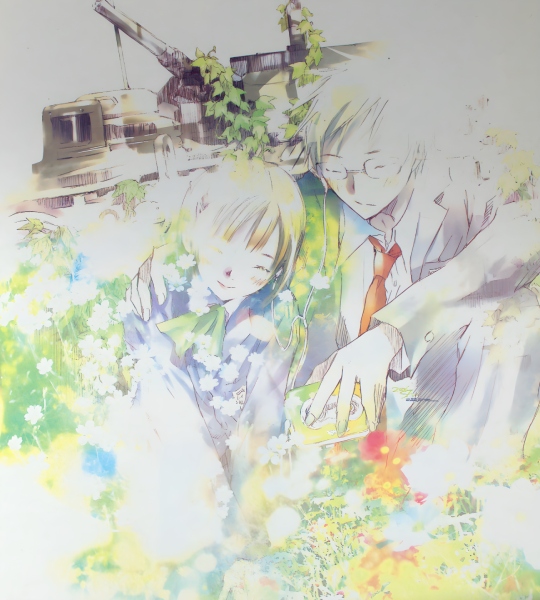One of the main reasons for creating my blog was to highlight manga and anime series that I fear will disappear. Lost to time.
Growing up, I always thought that our media would last forever. But even with our vast technology, things are being forgotten, either lost in licensing or old copies sitting in a basement somewhere. I realize now how important it is to preserve the media that has meant so much to me over the years. I do not want those I cherish to become obscure and forgotten.
Today I will be discussing one of the most influential manga series in my life. Saishu Heiki Kanojo, or Saikano for short, was a manga created by Shin Takahashi in the early 2000s. Now over 20 years old, this manga is hard to find in its entirety, and finding other works of his in English is almost impossible. I’m thankful enough to have finally obtained the entire collection. (Hunting down the last volume was tough—and expensive!) My hope is that one day his works will be licensed and redistributed.
Why do we tell stories? There are stories, I believe, that tap into the human condition with such precision and amplification that they resonate through you, like the shiver from a song that lifts you to a feeling you cannot describe. You want to hold onto this feeling and never let it go.
So you read the same book, watch the same show, or movie over and over. You know the characters by heart, you start to connect with them. You try to write fan fiction to expand the story you love. But it’s never quite as good. It’s then you realize you must make your own stories. But what should you write about? What made the ones you love so good?
When you pour yourself and your experiences wholeheartedly into what you create, that’s when you get stories that resonate with their audience, and that’s exactly what Shin Takahashi accomplished with Saikano.
At first glance, Saikano seems simple: a tragic love story set against an apocalyptic backdrop. But from this straightforward premise comes something deeply moving. The manga beautifully juxtaposes tender moments of innocent romance with stark realities of loss and conflict. It’s amazing how a few panels in a manga can bring out these emotions and give context to such complex parts of human existence.
There are plenty of romance manga—and no, this is not a typical Shojo Manga—but rather, a love story written with adolescent boys in mind, and this one is different. Yes, it’s a high school romance, but one steeped in war and the true struggles of life. It’s actually where I started to understand what relationships really were.
One quote from the manga has stuck with me ever since:
“In relationships, you will rub each other the wrong way, but it is through this friction that you come to better understand each other.”
This is one of those stories that resonated deeply, exploring love not as a mere romantic notion but as a complex and often painful connection that survives even in the harshest realities. It doesn’t offer magical embellishments or easy resolutions—it’s awkward, painful, mature, and profoundly authentic.
Saikano excels in depicting themes of innocence lost, isolation, and emotional turmoil with striking realism. Throughout its volumes, the manga presents characters coping with insurmountable pressures, mirroring real-life struggles with mental health, identity, and emotional isolation. The metaphor of Chise becoming a literal weapon reflects how we often feel burdened by our perceived shortcomings, responsibilities, or mental health challenges. I found myself deeply connected with Shuji and Chise, witnessing their tragic transformation from ordinary students into adults forced by extraordinary circumstances.
It was the first time I resonated so deeply with characters, and it helped shape the person I wanted to be. Shin Takahashi poured himself into his work and characters. Shuji and Chise are a direct reflection of himself and his wife.
His art style is unique; it doesn’t typically follow traditional manga styles and isn’t refined in a conventional sense. The imperfections and rough edges give his art its strength and character, beautifully encapsulating the emotional chaos within the story. The delicate lines contrasted by intense emotional visuals encapsulate the emotional turmoil with profound authenticity. This rough, jagged style doesn’t imitate or chase perfection but instead creates some of my favourite art pieces of all time.
Manga and anime often get a bad rap for being overly sexualized. Saikano does contain mature themes and images, but never in pursuit of explicitness for explicitness’ sake. There’s one tasteful nude of Chise with her metal wings forever burned into my memory—the soft colours, the gentle lines defining her frail body—it evokes profound beauty and profound sadness simultaneously.
Art like this, art that dares break the conventions of its industry, is rare in contemporary manga.
The story culminates with a poignant resolution—quiet acceptance, resilience, and remembrance—all encapsulated in a bittersweet ending that stays with you. It highlights that human connections, however brief or flawed, remain powerful, meaningful, and deeply human even amidst devastation.
I never want it forgotten how beautiful manga and anime can be. Beneath all the mainstream content are forgotten masterpieces that deserve revisiting, remembering, and preserving. Saikano is unquestionably one of them.
To Shin Takahashi, thank you for your hard work and pouring yourself into this incredible series. Know that, to this day, your work inspires people around the world—and this Canadian hasn’t forgotten how much Saikano means to him. Shuji and Chise are all of us.

